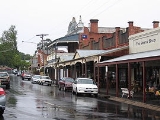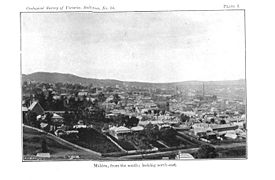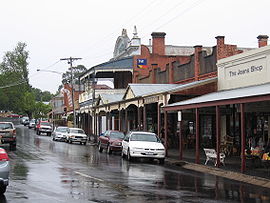
Maldon, Victoria
Encyclopedia
Maldon is a town in Victoria
, Australia
, in the Shire of Mount Alexander local government area. It has been designated "Australia's first notable town" and is celebrated for its 19th-century appearance, maintained since gold-rush
days. At the 2006 census
, Maldon had a population of 1,601.
were established in the area, at the foot of Mount Tarrangower. In December 1853, gold was discovered at Cairn Curran (the name given to one of the sheep runs), and Maldon became a part of the Victorian Gold Rush
.
The goldfield
, which was named "Tarrangower Fields" after Mount Tarrangower, immediately attracted an immense number of men eager to make their fortunes at the diggings. Just one month after gold was first discovered, the Chief Commissioner for Goldfields reported 3000 miners had arrived at the diggings. A month after that, a journalist
for The Argus
reported that the road from Castlemaine
to Maldon was lined with the shops of people hoping to make a living of their own from the miners:
 By 1856 there was estimated to be 18-20,000 people at the goldfields, and the Victorian government arranged for the settlement to become a town, which was named Maldon. The post office had opened on 14 March 1854.
By 1856 there was estimated to be 18-20,000 people at the goldfields, and the Victorian government arranged for the settlement to become a town, which was named Maldon. The post office had opened on 14 March 1854.
In 1861, a government census declared the town's population to be 3341, servicing an additional 5,000-6,000 miners at the diggings. At that time it was the eighth-largest town in Victoria, and remained so for the next decade. However, as miners were forced to dig deeper to obtain usable specimens, or as mines ran dry completely, the population began to decline. By 1891, Maldon was reduced to 1,600 inhabitants. Mining of small claims continued through the 20th century, together with sluicing of gullies and tailings. In the 1980s, several new ventures commenced, including an open cut at Union Hill.
Maldon proved to be one of Victoria's richest quartz-mining centres, though with poorer alluvial results than others such as Castlemaine or Ballarat. Quartz mining extended southward through Sandy Creek to Newstead, along to Mia Mia and Muckleford, eastward to Fentimen’s and Smith’s Reefs, and even to the apex of Mount Tarrangower. In all, over seventy reefs were proven to contain gold deposits. Maldon was undoubtedly a poor man’s diggings, with many excellent yields from very small claims.
Maldon Vintage Machinery Museum:
A fantastic museum continues to grow in Maldon that is run by volunteers and enthusiasts.It is home to objects large and small from the area such as stationary engines,farming implements,mining exhibits,fire pumps,and objects with links to Thompsons Foundary Castlemaine.It is situated not far off the main street and is well worth a visit.The volunteers are planning amazing things and are hampered only by time and their small work force.
 Today, Maldon's population is more or less stable at around 1,000 people. The town has changed very little since mining operations ceased, though a former bank at the junction of High and Main Streets has been supplanted by a service station
Today, Maldon's population is more or less stable at around 1,000 people. The town has changed very little since mining operations ceased, though a former bank at the junction of High and Main Streets has been supplanted by a service station
. The town was declared a "notable town" in 1966 by the National Trust of Victoria, who explained that:
Maldon is now sustained by its appeal as a retreat and retirement venue for artists and writers, as well as tourist trade
. The town holds several annual fairs, including a Winter Fair, Easter Fair, Art Show, and Folk Festival
. Notable landmarks include Beehive Chimney, Mount Tarrangower and fire tower, Lake Cairn Curran
, and the railway station
. Maldon has its own newspaper, the Tarrangower Times, which was first published in 1858 and is the oldest continuously published newspaper in Victoria. The Maldon Museum and Archives Association operates a district museum and family-history centre in the former Maldon Shire Hall, and a vintage machinery museum.
The minimum-security female prison HM Prison Tarrengower
is located to the near north of the township in the locality of Nuggety.
 The town has an Australian Rules football team competing in the Maryborough Castlemaine District Football League
The town has an Australian Rules football team competing in the Maryborough Castlemaine District Football League
.
Golfers play at the course of the Maldon Golf Club on Golf Links Road.
, set in the 1950s and starring Eric Bana
, was shot on location in Maldon. Romulus, My Father went on to win the Australian Film Institute
award for Best Film.
Victoria (Australia)
Victoria is the second most populous state in Australia. Geographically the smallest mainland state, Victoria is bordered by New South Wales, South Australia, and Tasmania on Boundary Islet to the north, west and south respectively....
, Australia
Australia
Australia , officially the Commonwealth of Australia, is a country in the Southern Hemisphere comprising the mainland of the Australian continent, the island of Tasmania, and numerous smaller islands in the Indian and Pacific Oceans. It is the world's sixth-largest country by total area...
, in the Shire of Mount Alexander local government area. It has been designated "Australia's first notable town" and is celebrated for its 19th-century appearance, maintained since gold-rush
Victorian gold rush
The Victorian gold rush was a period in the history of Victoria, Australia approximately between 1851 and the late 1860s. In 10 years the Australian population nearly tripled.- Overview :During this era Victoria dominated the world's gold output...
days. At the 2006 census
Census in Australia
The Australian census is administered once every five years by the Australian Bureau of Statistics. The most recent census was conducted on 9 August 2011; the next will be conducted in 2016. Prior to the introduction of regular censuses in 1961, they had also been run in 1901, 1911, 1921, 1933,...
, Maldon had a population of 1,601.
History
The district where Maldon now stands was first discovered by white Europeans in 1836, during Major Thomas Mitchell's famous Victorian expedition. It was settled soon afterwards by pastoralists, and two sheep runsStation (Australian agriculture)
Station is the term for a large Australian landholding used for livestock production. It corresponds to the North American term ranch or South American estancia...
were established in the area, at the foot of Mount Tarrangower. In December 1853, gold was discovered at Cairn Curran (the name given to one of the sheep runs), and Maldon became a part of the Victorian Gold Rush
Victorian gold rush
The Victorian gold rush was a period in the history of Victoria, Australia approximately between 1851 and the late 1860s. In 10 years the Australian population nearly tripled.- Overview :During this era Victoria dominated the world's gold output...
.
The goldfield
Gold mining
Gold mining is the removal of gold from the ground. There are several techniques and processes by which gold may be extracted from the earth.-History:...
, which was named "Tarrangower Fields" after Mount Tarrangower, immediately attracted an immense number of men eager to make their fortunes at the diggings. Just one month after gold was first discovered, the Chief Commissioner for Goldfields reported 3000 miners had arrived at the diggings. A month after that, a journalist
Journalist
A journalist collects and distributes news and other information. A journalist's work is referred to as journalism.A reporter is a type of journalist who researchs, writes, and reports on information to be presented in mass media, including print media , electronic media , and digital media A...
for The Argus
The Argus (Australia)
The Argus was a morning daily newspaper in Melbourne established in 1846 and closed in 1957. Widely known as a conservative newspaper for most of its history, it adopted a left leaning approach from 1949...
reported that the road from Castlemaine
Castlemaine, Victoria
Castlemaine is a city in Victoria, Australia, in the Goldfields region of Victoria about 120 kilometres northwest by road from Melbourne, and about 40 kilometres from the major provincial centre of Bendigo. It is the administrative and economic centre of the Shire of Mount Alexander. The...
to Maldon was lined with the shops of people hoping to make a living of their own from the miners:
The narrow road ... is lined on each side almost continuously with stores of every description, saloons, restaurants, eating houses, lemonade and beer shops, apothecaries' shops, and the tents of doctors, who, I am sorry to say, drive a very lucrative business at Tarrangower.

In 1861, a government census declared the town's population to be 3341, servicing an additional 5,000-6,000 miners at the diggings. At that time it was the eighth-largest town in Victoria, and remained so for the next decade. However, as miners were forced to dig deeper to obtain usable specimens, or as mines ran dry completely, the population began to decline. By 1891, Maldon was reduced to 1,600 inhabitants. Mining of small claims continued through the 20th century, together with sluicing of gullies and tailings. In the 1980s, several new ventures commenced, including an open cut at Union Hill.
Maldon proved to be one of Victoria's richest quartz-mining centres, though with poorer alluvial results than others such as Castlemaine or Ballarat. Quartz mining extended southward through Sandy Creek to Newstead, along to Mia Mia and Muckleford, eastward to Fentimen’s and Smith’s Reefs, and even to the apex of Mount Tarrangower. In all, over seventy reefs were proven to contain gold deposits. Maldon was undoubtedly a poor man’s diggings, with many excellent yields from very small claims.
Maldon Vintage Machinery Museum:
A fantastic museum continues to grow in Maldon that is run by volunteers and enthusiasts.It is home to objects large and small from the area such as stationary engines,farming implements,mining exhibits,fire pumps,and objects with links to Thompsons Foundary Castlemaine.It is situated not far off the main street and is well worth a visit.The volunteers are planning amazing things and are hampered only by time and their small work force.
Modern times

Filling station
A filling station, also known as a fueling station, garage, gasbar , gas station , petrol bunk , petrol pump , petrol garage, petrol kiosk , petrol station "'servo"' in Australia or service station, is a facility which sells fuel and lubricants...
. The town was declared a "notable town" in 1966 by the National Trust of Victoria, who explained that:
The township displays overall historical and architectural importance, particularly in its gold town buildings. The significance lies in the variety of building styles, and the area of mining is of interest with one mine still open to the public. Maldon boasts that it is largely unchanged since the 1850s, and has attracted considerable interest from tourists for its 19th-century atmosphere.
Maldon is now sustained by its appeal as a retreat and retirement venue for artists and writers, as well as tourist trade
Tourism
Tourism is travel for recreational, leisure or business purposes. The World Tourism Organization defines tourists as people "traveling to and staying in places outside their usual environment for not more than one consecutive year for leisure, business and other purposes".Tourism has become a...
. The town holds several annual fairs, including a Winter Fair, Easter Fair, Art Show, and Folk Festival
Folk music
Folk music is an English term encompassing both traditional folk music and contemporary folk music. The term originated in the 19th century. Traditional folk music has been defined in several ways: as music transmitted by mouth, as music of the lower classes, and as music with unknown composers....
. Notable landmarks include Beehive Chimney, Mount Tarrangower and fire tower, Lake Cairn Curran
Cairn Curran Reservoir
Cairn Curran reservoir is situated along the Loddon River near the townships of Baringhup, Newstead and Welshmans Reef in Victoria, Australia....
, and the railway station
Maldon railway station, Victoria
Maldon is a historic railway station on the Victorian Goldfields Railways Maldon branch line, off the main Bendigo, Echuca and Swan Hill lines in central Victoria, Australia.- History :...
. Maldon has its own newspaper, the Tarrangower Times, which was first published in 1858 and is the oldest continuously published newspaper in Victoria. The Maldon Museum and Archives Association operates a district museum and family-history centre in the former Maldon Shire Hall, and a vintage machinery museum.
The minimum-security female prison HM Prison Tarrengower
HM Prison Tarrengower
HM Prison Tarrengower is a women's prison located in Maldon, Victoria, Australia.-History:Originally a farm, the prison was opened in January 1988 after the property was purchased and accommodation units were built. Tarrengower is the only minimum security female prison in Victoria...
is located to the near north of the township in the locality of Nuggety.
Sport

Maryborough Castlemaine District Football League
The Maryborough Castlemaine District Football League is an Australian rules football league based in central Victoria. This is a minor league with clubs coming from towns near the regional centres of Maryborough, and Castlemaine.-History:...
.
Golfers play at the course of the Maldon Golf Club on Golf Links Road.
Events
The town has an annual Easter Fair which includes events such as billy-cart racing, dancing in the street, the Great Aussie Scone Bake, a cemetery walk and the lighting of the Mount Tarrangower tower. The Maldon Folk Festival has been held annually since 1974. (31 October to 3 November in 2008).In popular culture
Much of the 2007 film Romulus, My FatherRomulus, My Father (film)
Romulus, My Father is a 2007 Australian drama film directed by Richard Roxburgh. Based on the memoir by Raimond Gaita, the film tells the story of Romulus and his wife Christine , and their struggle in the face of great adversity to raise their son, Raimond . The film marks the directorial debut...
, set in the 1950s and starring Eric Bana
Eric Bana
Eric Bana is an Australian film and television actor. He began his career as a comedian in the sketch comedy series Full Frontal before gaining critical recognition in the biopic Chopper...
, was shot on location in Maldon. Romulus, My Father went on to win the Australian Film Institute
Australian Film Institute
The Australian Film Institute was founded in 1958 as a non-profit organisation devoted to developing an active film culture in Australia and fostering engagement between the general public and the Australian film industry...
award for Best Film.
Notable residents
- Bill WoodfullBill WoodfullWilliam Maldon "Bill" Woodfull OBE was an Australian cricketer of the 1920s and 1930s. He captained both Victoria and Australia, and was best known for his dignified and moral conduct during the tumultuous bodyline series in 1932–33 that almost saw the end of Anglo-Australian cricketing ties...
, former Australian cricket teamAustralian cricket teamThe Australian cricket team is the national cricket team of Australia. It is the joint oldest team in Test cricket, having played in the first Test match in 1877...
captain, born in Maldon on 27 August 1897 - Joseph JenkinsJoseph JenkinsJoseph Jenkins , was an educated tenant farmer from Tregaron, Ceredigion, mid-Wales who, when aged over 50, suddenly deserted his home and large family to seek his fortune in Australia...
, the Welsh SwagmanSwagmanA swagman is an old Australian and New Zealand term describing an underclass of transient temporary workers, who travelled by foot from farm to farm carrying the traditional swag...
, maintained Maldon's gutters and drains for one pound per week from 1885-1894 - Henry Handel RichardsonHenry Handel RichardsonHenry Handel Richardson, the pseudonym used by Ethel Florence Lindesay Richardson, was an Australian author. She took the name "Henry Handel" because at that time, many people did not take women's writing seriously, so she used a male name...
, the Australian author, spent some of her childhood in Maldon when her mother was postmistress there, and wrote about the town in her memoir, Myself When Young - Frank Arthur NankivellFrank Arthur NankivellFrank Arthur Nankivell was an Australian artist and political cartoonist.Nankivell was born to John and Annie Nankivell in Maldon, northwest of Castlemaine, Victoria in April, 1869. He was a book illustrator in New York circles of the 1910s and 1920s on such publications as Puck, which was...
, artist

